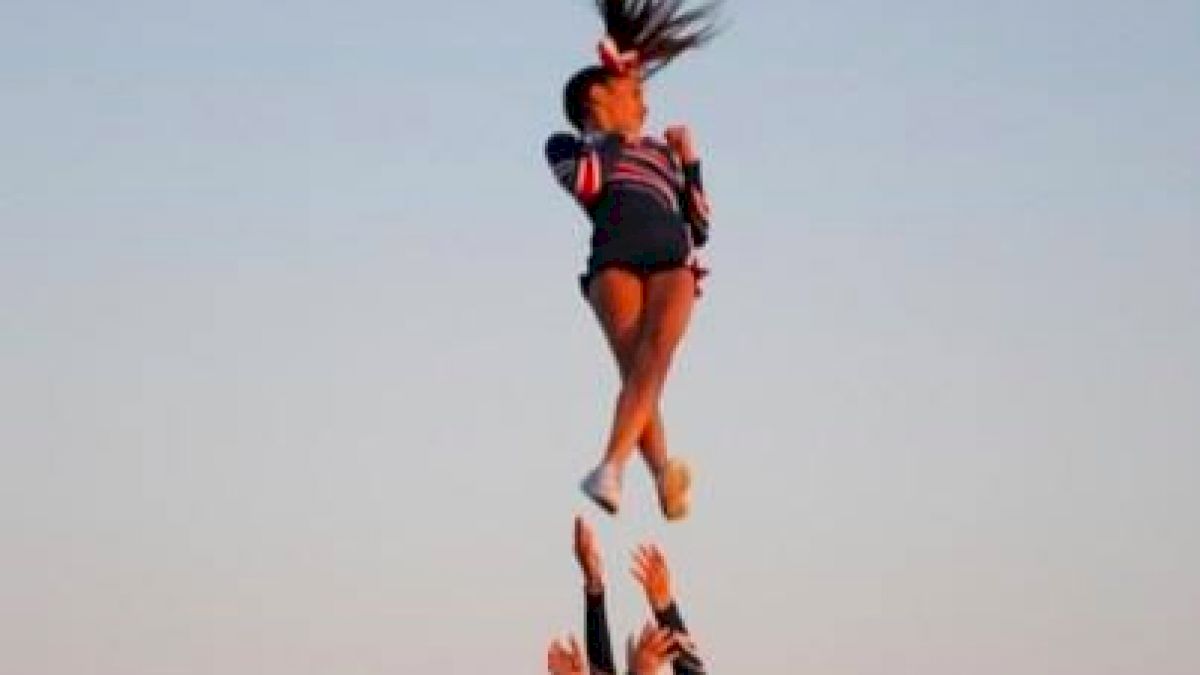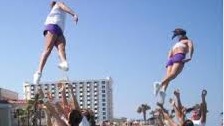Performing a Full Twist Cradle
Performing a Full Twist Cradle
Full downs, also called twist cradle or full-twist cradle, are advanced cheerleading dismounts in which the flyer is popped out of the bases hands and execu

Full downs, also called twist cradle or full-twist cradle, are advanced cheerleading dismounts in which the flyer is popped out of the bases hands and executes a 360- degree turn prior to landing in a cradle. This dismount can be executed from should or extended level and may be performed from numerous stunts such as liberties, heel stretches, and pyramids.
· Remember all stunts should be performed only under the supervision of a qualified cheerleading coach and after successfully mastering the previous progressions.
Perfect Straight Cradling Technique:
Before attempting a full down cradle, you must master a regular pop cradle from half and extended positions. Key to a successful full down is learning how to ride the pop. Begin by perfecting your straight cradle technique. Flyers start with your arms in a high V. After the bases dip (only using the legs, not arms) and drive their hands above their heads, releasing the feet. The flyer, keeping her legs locked, will ride the pop as high as possible with arms glued to her sides, legs together, shoulders shrugged and belly pulled in. Once the flyer has reach the crest of the pop, begin to pull a pike position while putting your hands in a T position to wrap around your two bases. The back spot maintains eye contact with the top girl’s head and neck. On the catch the back spot will scoop her arms under the flyer’s shoulders resisting on the way down into the cradle position. Practice the straight cradle until it is a fluid, high toss and performed with perfection from both the shoulder and extended heights.
Learn to Twist:
It is great to establish memory of motion by having the flyer go through the motions of the 360 turn on the ground before it is attempted in the stunt. One technique is to have the flyer rotate and fall into a crash mat. Stand on an elevated surface with your back to the mat with arms in a high V, pick a place in front of you to spot. Take a big jump off the elevated surface as you simultaneously pull your arms down to your left side while looking over the left shoulder. This will initiate the twist. Keeping your eyes open to find the area you are spotting on the wall. When you see this spot, sit in your pike positing on the mat. Goal here is to twist in a slight angle before piking on the mat.
If you do not have a crash mat, another twisting drill is for the flyer to stand on the ground directly in front of her back spot. Flyers arms are in a high V. Take a dip, coming up off your toes, slightly above the ground. At the same time, begin the spin by quickly pulling your arms down to the left while looking over the left shoulder and fall back into the spotter’s arms. Spotter will catch the flyer under the arms as if in a cradle catch.
Performing the Twist Cradle:
First, master a twist cradle from a half-elevator. For the bases and back spot, the motion is the same as in a pop cradle; bend with the knees, shrug through the shoulder and pop hands above your head. Flyers begin with arms in a high V. Keeping legs tight, ride the pop and pulling your arms to you left side, looking over left shoulder. You should hold your body straight with your abs pulled in tight to keep a hollow shape to your body. Spot the front as you finish the rotation and landing in a cradle position.

Common Errors:
-Bases make sure you pop the flyer straight up. Don’t try to help the flyer twist or throw in a certain direction.
-Flyers ride the pop to the top before you begin to twist. A very common mistake is twisting right out of your bases hands. Avoid the
temptation of twisting too soon.
-Flyers keep your body tight as you twist. In the twisting position, your body should remain in a straight line at all times. Don’t twist
your shoulders then your hips. Everything must twist together.
· Remember all stunts should be performed only under the supervision of a qualified cheerleading coach and after successfully mastering the previous progressions.
Perfect Straight Cradling Technique:
Before attempting a full down cradle, you must master a regular pop cradle from half and extended positions. Key to a successful full down is learning how to ride the pop. Begin by perfecting your straight cradle technique. Flyers start with your arms in a high V. After the bases dip (only using the legs, not arms) and drive their hands above their heads, releasing the feet. The flyer, keeping her legs locked, will ride the pop as high as possible with arms glued to her sides, legs together, shoulders shrugged and belly pulled in. Once the flyer has reach the crest of the pop, begin to pull a pike position while putting your hands in a T position to wrap around your two bases. The back spot maintains eye contact with the top girl’s head and neck. On the catch the back spot will scoop her arms under the flyer’s shoulders resisting on the way down into the cradle position. Practice the straight cradle until it is a fluid, high toss and performed with perfection from both the shoulder and extended heights.
Learn to Twist:
It is great to establish memory of motion by having the flyer go through the motions of the 360 turn on the ground before it is attempted in the stunt. One technique is to have the flyer rotate and fall into a crash mat. Stand on an elevated surface with your back to the mat with arms in a high V, pick a place in front of you to spot. Take a big jump off the elevated surface as you simultaneously pull your arms down to your left side while looking over the left shoulder. This will initiate the twist. Keeping your eyes open to find the area you are spotting on the wall. When you see this spot, sit in your pike positing on the mat. Goal here is to twist in a slight angle before piking on the mat.
If you do not have a crash mat, another twisting drill is for the flyer to stand on the ground directly in front of her back spot. Flyers arms are in a high V. Take a dip, coming up off your toes, slightly above the ground. At the same time, begin the spin by quickly pulling your arms down to the left while looking over the left shoulder and fall back into the spotter’s arms. Spotter will catch the flyer under the arms as if in a cradle catch.
Performing the Twist Cradle:
First, master a twist cradle from a half-elevator. For the bases and back spot, the motion is the same as in a pop cradle; bend with the knees, shrug through the shoulder and pop hands above your head. Flyers begin with arms in a high V. Keeping legs tight, ride the pop and pulling your arms to you left side, looking over left shoulder. You should hold your body straight with your abs pulled in tight to keep a hollow shape to your body. Spot the front as you finish the rotation and landing in a cradle position.

Common Errors:
-Bases make sure you pop the flyer straight up. Don’t try to help the flyer twist or throw in a certain direction.
-Flyers ride the pop to the top before you begin to twist. A very common mistake is twisting right out of your bases hands. Avoid the
temptation of twisting too soon.
-Flyers keep your body tight as you twist. In the twisting position, your body should remain in a straight line at all times. Don’t twist
your shoulders then your hips. Everything must twist together.